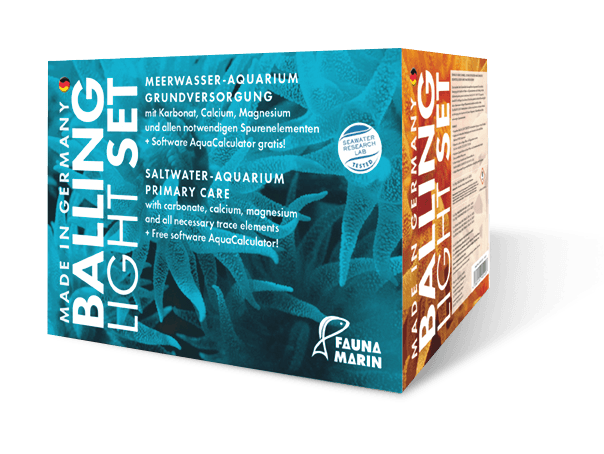Bromine
Bromine is an often underestimated element, but for corals it is extremely important. Stony corals use bromine for the synthesis of colouring chromoproteins, and they need it to form their skeletal structure. Zooxanthellae use it for the production of enzymes that are irreplaceable in photosynthesis. Some soft corals, such as Dendronephthya, accumulate bromine in their tissues and use it as a raw material for toxin production so that plankton can be caught. Gorgonians and algae also accumulate bromine in their tissues. The consumption is rather low even in heavily populated tanks. Our measurements showed that a daily replenishment of approx. 0.7–1.2 mg bromine/100 l (26 US.liq.gal.) can keep the value stable. A lower bromine value is not much harmful for most corals, but the fluorescence and the glow of the corals are quickly lost.
What’s that:
Bromine belongs to the halogens and is an important macro element in seawater. Bromine is an essential element that has a direct effect on biological processes and the growth of corals as well as an inhibitory effect.
Problems:
Too little bromine leads to loss of colour and growth, especially in soft corals, gorgonians, sponges, but also hard corals. Bromine is also important for the formation of fluorescent effects. Too high values from approx. 90 mg/l (0,26 US.liq.gal.) cause tissue detachment, starting in the middle portion of the coral.
Measures:
Regularly control the bromine value, if necessary adjust the dosage, reduce it by partial water change and use of activated carbon
Indicator species:
A too low bromine value is reflected in pale colours, the loss of blue and purple fluorescence (indicator species Cespitularia soft corals and blue Xenia species as well as gorgonians). Aquaria with too low bromine concentration usually develop more severe damage when parasites appear.
Value too high:
Reduce the addition dosage, perform partial water changes, avoid values above 80 mg/l (0,26 US.liq.gal.), use activated carbon Carb L.
Value too low:
Dose Elementals Br.
| Variety | Halogen, macro element |
|---|---|
| Reference value | 60–70 mg/l (0,26 US.liq.gal.) |
| Skill Level | Orange, only for experienced aquarists |
| Source | salt mix, supply systems, trace element mixtures, base solutions, contaminated calcium salts |
| Available | Elementals Br, Balling-Light-System, Feed |
| Detection quality | reliable |

Balling Light:
If the values are too low, increase the doses via Trace 3. Adjust the existing dose. Pay attention to the iodine value here. If the iodine value is correct, increase the dosage via Elementals Br or change to Professional Sea Salt.
Bromine
Bromine occurs in seawater in relatively high concentrations of 60–70 mg/l (0,26 US.liq.gal.), mainly as bromide. This means that this halogen belongs to the macro elements and is the seventh most concentrated of all elements dissolved in seawater. Nevertheless it is mostly ignored by coral reef aquarists.
Bromine has a brightening effect on the coral tissue and provides a porcelain-like coloration, even under very blue-dominated lighting. Below a value of 50 mg/l (0,26 US.liq.gal.) there is a weaker polyp expansion and the colours become blurred, especially with multicoloured hard corals. For a good color contrast, a bromine value of at least 65–70 mg/l (0,26 US.liq.gal.) is necessary.
But bromine is not only important for colour development. Gorgonians use a horn scleroprotein called gorgonin to stabilize the skelet. This protein contains high proportion of bromine, which, together with other halogens and amino acids, provides the skeletal substance. Some soft corals such as blue fluorescent Cespitularia lose their blue colour if the bromine levels are too low.
It is often read that bromide is converted into poisonous bromate by using ozone. We carried out many experiments in which this could not be proven. In principle, however, when using ozone, the water should be filtered through activated carbon, whereby any bromate present in addition to residual ozone would very well be adsorbed.
Tip:
With the Fauna Marin Reefkeeping Systems, the calcium supply and trace element supply is ensured by inorganic products. The supply of vitamins, organic additives and amino acids is regulated separately, additional vitamin doses are not necessary as these are integrated in the corresponding further products and also contained in the Balling Light System.